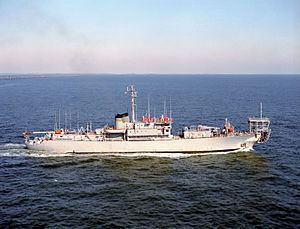Laid down 14 April 1945 Struck 7 November 1994 Construction started 14 April 1945 Length 112 m Displacement 7.09 million kg Beam 14 m | Commissioned 13 May 1963 Fate recycled in late 2005 Launched 7 November 1945 Weight 7,940 tons Draft 5.5 m | |
 | ||
Namesake Brig. Gen. Albert J. Myer Honors and
awards Meritorious Unit Commendation (1974), four Navy "E" Ribbons (1981, 1982, 1984, and 1985) | ||
USNS Albert J. Myer (ARC-6) was the second of only two Maritime Commission type S3-S2-BP1 ships built for the US Army near the end of World War II. The other ship was the William H. G. Bullard, later USS Neptune, which Myer later joined in naval service. She is named for Brig. Gen. Albert J. Myer, the founder of the Army Signal Corps. The keel was laid down on 14 April 1945 by Pusey & Jones Corp. of Wilmington, Delaware as Hull Number 1109. Albert J. Myer was launched on 7 November 1945, and sponsored by Mrs. Grace Salisbury Ingles, the wife of Major General Harry C. Ingles, commanding officer of the Army Signal Corps. After brief reactivation by Army Myer was transferred to the Navy for service as USNS Albert J. Myer (T-ARC-6).
Contents
Function
Myer's projects have typically been to transport, deploy, retrieve and repair submarine cables, test acoustic devices, and conduct acoustic, hydrographic, and bathymetric surveys.
U.S. Army
Since World War II ended some eight months before her completion, the Albert J. Myer was delivered to the Maritime Commission 17 May 1946 and placed in the National Defense Reserve Fleet, James River Group, Lee Hall, Virginia. Myer was again taken in by the US Army, 7 February 1952 commissioned as USACS Albert J. Myer where she worked on the Alaska Communications System, projects for Navy and Air Force and the Hampden, Newfoundland shore ends of CANTAT-1 (CANadian TransAtlantic Telephone cable).
U.S. Navy
Myer was returned to the Maritime Administration (MARAD), 13 June 1966, and simultaneously transferred to the US Navy where she served as the cable repair ship operated by the Military Sea Transportation Service (MSTS) (later Military Sealift Command (MSC)) as USNS Albert J. Myer (T-ARC-6) in support the SOSUS program.
The Albert J. Myer was extensively modernized in 1980 by Bethlehem Steel in Baltimore, Maryland. This included new turbo-electric engines replacing two Skinner Uniflow Reciprocating Steam Engines. It is said that Myer and her sister ship Neptune were the last ships in the Navy to operate using reciprocating steam engines.
Myer performed cable repair duties all over the world until 1994, when she'd been in active service for nearly 42 years. During her career, she received a Meritorious Unit Commendation (1974), and four Navy E ribbons (1981, 1982, 1984, and 1985).
She was inactivated in 1994 and eventually placed in the James River reserve fleet near Ft. Eustis, VA. She was dismantled and recycled by International Shipbreaking Ltd of Brownsville, TX in late 2005.
